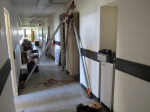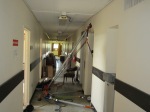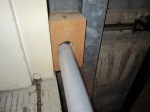Here are some new AZV uses we at R2T have been testing to see the real world practicality of. There are some earlier proof of concept pictures on the multimedia page, but these were done in exposure with a two person load. They’re all versions of what we’ve decided to call the Appalachian Doortex (APD), an obvious attempt at getting some East Coast love into the rope world.
The purpose of these APD is to create either an anchor, a high directional, or both simultaneously in the urban environment. The initial thought was for use in elevators, but can obviously work to create an anchor anywhere there is a solid block wall surrounding a door. We run A LOT of stalled elevators in in the city where I work, 15 a day is about average in our geographically small city. Not many require any rope work at all, but the one’s that do can be a real pain. Have you ever looked in an elevator lobby for anchors or a high directional? Not much around. That’s the problem we were trying to solve.
The “Ram’s Head” is the first version we came up with. In this configuration we hooked both MPDs right to the head of the APD; there was no guying, tying, or anything. The foot of the lazy leg was not resting against the opposite wall. Aside from a very minor initial settling in of the APD, it did not move during the operation. It was loaded with a two person load that was raised and lowered several times. One of the MPDs was hooked up in a fashion that caused it to bind against the head of the AZV a bit because it allowed us to have the operating handle facing outward. Because of the angle of the rope leaving the MPD into the elevator shaft, this very minor binding was felt not to be an issue.
Next up is an Upside Down APD, with no clever name given yet. Maybe the Appalachian Lean-To (ALT)? Yup we’ll go with that for now. Just another way to make an anchor/HD combo. Also loaded with a two person load, operated up and down a bunch.
Here is the close up of the dual MPD anchoring on the Appalachian Lean-To.
Below are two pictures of what we used to keep the the Appalachian Lean-To from kicking back should it have wanted to. It didn’t want to. We had a dynomometer in there to see if there was any force trying to push the ALT away from the opening. The needle didn’t move at all during the operation. We were pulling against an extra leg section of an AZV run through two 4×6 blocks with holes drilled in them to keep the leg section from resting on a small, roll prone contact point on the hoistway doors. We’ve been calling them “Brace Blocks” (Appalachian Brace Blocks?) They worked really well. I suspect they can be used to help span doorways in buildings to create quick, simple anchors in a hallway.
While we have not tested a center pulled AZV leg to failure yet, this one was pulled to 500 lbs without any visible deflection. Further testing on this configuration will be conducted in the near future and we’ll let you know what we find out.
If anybody has any thoughts, questions or comments on this, or would like further training on operating on rope in an urban environment please feel free to leave a comment below or send Kelly an email directly at rescue-2@comcast.net.






